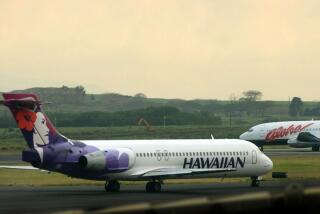A Not-So-United Reply
- Share via
United Airlines announced last April a plan to buy all of Pan Am’s Pacific routes. In a decision so quick that it surprised some people, the Department of Transportation approved the $750-million transaction in November.
United is scheduled to start flying its new routes later this month.
Not so fast, fellas. A teeny hitch may be developing.
Some of the foreign governments involved would like the United States to sweeten the pot for them as the price for allowing United to substitute for Pan Am in air services that were negotiated in bilateral discussions.
Their message is, in effect: “If you want to change the rules in mid-game, let’s talk about what’s in it for us.”
Bargaining Chips
United can’t start flying into any country that hasn’t given its approval, and some Pacific nations are suggesting that the approval they gave Pan Am isn’t exchangeable.
The U.S. position is diametrically opposed. The State Department is arguing, with some justification, that bilateral agreements specify only what routes may be flown, how many seats and on how many flights . . . not the identity of the carrier to operate them.
Japan, for one, doesn’t agree. And it is threatening to hold United “hostage” until the U.S. goes back to the bilateral bargaining table.
Japan is said to want more cargo service into this country from Tokyo.
On another front, Thailand’s aviation authorities are making similar noises about rejecting United’s landing permits unless its national carrier, Thai Airways, is allowed to fly more often from the United States. The airline operates four flights a week from Dallas to Bangkok via Seattle and has the right, under existing agreements, to expand that to one a day.
Why Wait Till 1987?
But not until 1987. And Thailand would like that timetable speeded up so that it can begin daily service as soon as possible.
If not, Thai officials say, they just may not give United the green light to fly into Bangkok.
The big route for United, though, is U.S-Tokyo. So lucrative is that segment, so pivotal to any hope of success in the Pacific, that a clause in the United-Pan Am contract stipulates that the deal is off unless Japanese landing rights are transferred intact.
Partly, Japan and Thailand are simply being opportunistic. They know that the United-Pan Am deal is the biggest single route swap in history, and they believe they may be able to finesse something out of us by threatening to hold it up.
But also, those countries are acting in defense of their national airlines. The entry of United into the Pacific market in a big way will produce instant gigantic competition.
Japan Air Lines and Thai Airways must rely on U.S. domestic airlines to feed passengers from interior points to their gateway cities. With its 50-state route system, United is going to deliver its Pacific passengers to gateway cities all by itself.
There’s a lot at stake for everybody.
Europe in Second Place
Government statistics tell us that the volume of U.S. trade with Pacific rim countries recently surpassed the volume of trade with Europe. For the first time ever.
With one fell swoop--and a $750-million cashier’s check--United will thrust itself into this vast, and growing, market in a big way. The Illinois-based carrier has had limited Pacific service for several years, not anywhere near enough to enable it to make a real splash.
When the Pan Am deal is consummated, United will be in a position to make the kind of splash that could develop into a tidal wave.
For Pan Am, the route sale means a valuable infusion of much-needed cash. The close-out of Pacific operations will permit the carrier to concentrate its efforts in U.S.-Europe service, in which it has vowed to become a force.
Unthinkable as the idea is of Pan Am pulling out of the Pacific, an area that it pioneered more than half a century ago, this deal really could work to the advantage of both parties.
If, that is, the United States can overcome the grumblings of those foreign governments.
Chances are that that grumbling will continue. In fact, other countries may join in.
But chances are good also that United will start flying Jan. 28, as planned, against a backdrop of an unwritten but tacit pledge by the State Department to give some thought to the concerns and the wishes of Japan and Thailand, and any others who may decide to chip in.
And, in the end, it’s likely that they will indeed all get a little something extra as a pot sweetener.
More to Read
Inside the business of entertainment
The Wide Shot brings you news, analysis and insights on everything from streaming wars to production — and what it all means for the future.
You may occasionally receive promotional content from the Los Angeles Times.










